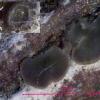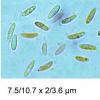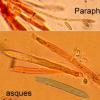
17-12-2015 12:11
 Lothar Krieglsteiner
Lothar Krieglsteiner
This Ombrophila was collected in the National Park

17-12-2015 11:54
 Lothar Krieglsteiner
Lothar Krieglsteiner
.. found 15.8.2015, National Park of "Eifel", in m

16-12-2015 01:20
Iglesias Plácidoje vous mets des photos et quelque chose de micro

16-12-2015 20:47
Eduard OsieckThis striking fluffy pyrenomycete grew from old st

16-12-2015 17:21
Alessandro Fellinon fallen branch (think Crataegus) on the ground i

16-12-2015 08:18
 Blasco Rafael
Blasco Rafael
Hola Tengo esta muestra recogida ayer sobre agujas
Merci de m'aider

Hello Daniele,
I fear the dead structures (stained in ?) you show are not sufficient to say too much about your discomycete. First of all, I miss any information about the excipulum.
I would guess that the excipulum contained of round cells with dark pigment and the living paraphyses contained an elongated vacuolar body. If this is right it would be a species of Mollisia. But then, the determination job only begins ...
Things you surely need are for instance: reaction of the porus with IKI (likely euamyloid), reaction with KOH (yellow or not), contents of the living spores (pattern of guttules) and presence of croziers (likely yes). With all this information, you will get closer to the aim ...
Regards from Lothar




